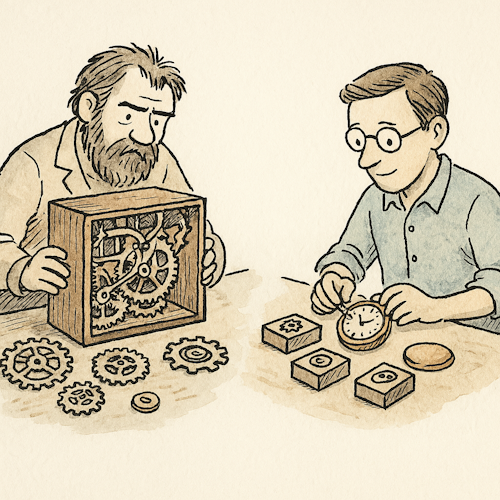The Clockmaker & The Watchmaker
Illustrates Modularity, Dependency Management, Organizational Design
Agile teams often struggle when complexity scales beyond what any one person can manage. Silos form. Dependencies multiply. Delivery slows. This parable reveals the hidden impact of how we structure our systems and teams.
This tale, inspired by Herbert A. Simon's 1962 essay The Architecture of Complexity1, which introduced the metaphor of Tempus and Hora to illustrate the resilience of modular systems over tightly coupled ones, is not just for engineers. It is for leaders, architects, Scrum Masters, and coaches - anyone involved in shaping the flow of work.

Once, there were two master craftsmen. One was a clockmaker named Elias. The other, a watchmaker named Rowan.
Elias designed grand, intricate clocks for halls and towers. They were beautiful, precise, and made of hundreds of tiny pieces. But if a spring popped loose or a gear was misplaced, the whole mechanism froze. Repairing it required taking the entire clock apart. Each build took months. Sometimes, the clocks never ran again after the first failure.
Rowan, on the other hand, made small pocket watches. His approach was different. He built them in modules. Each piece, a dial, a spring, a cog, was assembled independently. If something failed, it could be removed and replaced without affecting the rest.
When Elias' clocks broke, they sat in disrepair for weeks, even months. Fixing them meant dismantling everything.
Rowan, on the other hand, could replace a broken part and have the watch ticking again before lunch.
Over time, Rowan built more watches, made fewer mistakes, and recovered faster when he did. His pace wasn't rushed. It was resilient.
One day, Elias visited Rowan's shop, puzzled.
“How do you build so fast?” Elias asked.
Rowan smiled and laid out his designs. “I don't build faster,” he said. “I just build so things break better.”
Lessons Learned
Modularity Enables Agility
Rowan's success came not from working faster, but from structuring his work to absorb failure. Agile teams benefit from the same approach. When work is broken into independent units, be they microservices, product features, or team responsibilities, teams can deliver incrementally and respond to change with less disruption.
Tightly Coupled Systems Are Fragile
Elias' clocks represent monoliths: elegant but brittle. When every part depends on every other, even small defects can halt progress. Agile organizations must pay attention to coupling. Reducing unnecessary dependencies increases resilience and speeds up recovery from mistakes.
Simplicity is a Design Strategy
Rowan's watches were not simpler in function, but in structure. This mirrors the Agile principle of maximizing the amount of work not done. Complex solutions are sometimes necessary, but they should be built on simple foundations. Clean interfaces, clear contracts, and well-scoped components matter.
Teams Mirror Their Architecture
Rowan could work in parallel because his design allowed it. In contrast, Elias was stuck in sequential handoffs. Conway's Law reminds us that the way we design systems influences how we structure teams—and vice versa. If we want faster, more adaptive delivery, we must look at both.
Coaching Tips
- Use This Parable in Architecture Conversations: When tech leaders resist decoupling systems or services, this story offers a gentle, visual reminder of the tradeoffs in system design.
- Help Teams Visualize Dependencies: Create a map of your team's current workflow. Highlight where one change blocks others. Ask, “Are we building like Elias or Rowan?”
- Facilitate Conversations on Org Structure: Use this parable when discussing team topologies or cross-team collaboration. It opens the door to talking about Conway's Law and coordination costs.
- Support MVP Thinking: Emphasize that modular thinking also applies to product development. Can we deliver one “watch part” at a time? What value can be tested now without finishing everything?
Agile organizations are not just faster because of mindset. They are faster because of structure. Rowan's wisdom was in anticipating change and building for it.
Like watchmakers, Agile teams thrive when they design not only for success, but for graceful failure.
Let your teams build small, swap easily, and stay in motion. That is how time keeps ticking forward.


